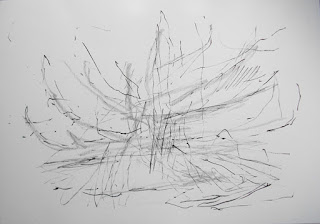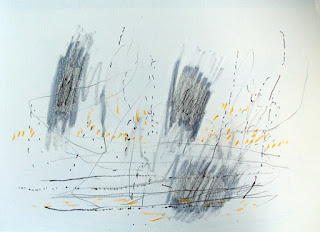Here we go again. This letter was the second to be refused by Knack
magazine – my reaction to yet another eulogy to Luc Tuymans, by the ‘critic’ Jan
Braet. Earlier, I had once already contacted the chief editor, protesting that unlike in the domains of music, literature, performing arts - in reviews of the 'plastic arts', in reviews of painting, there is never a trace of criticism to be found. I was courteously fobbed off.
After reading his last piece on Luc Tuymans (Knack
nr. 34), I feel the urge to console and pacify Jan Braet. I wish he would not
get so angry with the art of painting , that “penitent bitch,” as he calls her,
twice, with her “vain display.” What has she actually ever done to him?
Besides, Luc Tuymans has got her under control, hasn’t he? He stands “lucidly”
in this “mediatized world,” a whip in one hand – in the other he wields a chair:
his “possible” Photoshop program. And thus he tames the art of painting – the “bitch.”
In the literature on Tuymans’ oeuvre, the same observations are made over and
over again: his ‘images’ are “closed like an oyster” (Jan Braet); he paints “un-humanely
– without temperament, without distinction, without judgement, without affect, […]
he makes images from other images […], he copies images” (Dirk Lauwaert); “Tuymans
wants to be as impersonal, unfocused, uninspired as possible” (Frank Van de Veire).
“The anonymous gaze of Tuymans” (Bernard Dewulf).
The learned gentlemen critics note all of this in
awe, full of admiration, as if it were an enigma and a virtue at the same time.
The answer, however, is very simple, and is staring them in the face: Luc Tuymans
copies photographs. I repeat, he copies photo’s, just as children used to trace Mickey Mouse: ‘un-humanely, without temperament, without distinction,
without judgement, without affect, impersonally, uninspired, anonymously.’ Full
stop.
Tuymans, in this mediatized world, is merely the
most humble subject of “Queen One-eye” (as W.F. Hermans used to call the camera
– photography). At present, he is the most adulated of the ‘photocopyists’,
albeit certainly not the first: cf. Xavier Mellery (1845-1921), and not the last either (Michaël Borremans, Rinus Van de Velde). They are all makers of ‘images’,
which does not mean that they are painters. For painters are not “lucid.”
And as to “real painting” - it is not a “window to
the world,” it has nothing to do with “oils on canvas,” as Jan Braet seems to think,
and least of all does it involve copying pictures of ‘the’ reality (in casu images with a more or less sinister “background story”).
Dear Jan Braet, don’t worry: ‘the’ reality does
not exist: it is an illusion – sometimes it is created by real painters. That
is painting, and it is ever “forfeited,” or else it would cease to exist. And
if she must be called a “bitch” – what then would you call uncritical
criticism?
Na het lezen van zijn laatste stukje over Luc
Tuymans (Knack nr. 34), overvalt mij de behoefte om Jan Braet te troosten, en
een beetje te sussen. Ik wenste dat hij niet zo boos werd op de schilderkunst,
de “boetvaardige teef,” zoals hij haar tot tweemaal toe noemt, met “haar ijdele
vertoon.” Wat heeft ze hem eigenlijk misdaan? Luc Tuymans heeft haar immers
onder controle, niet? Hij staat “lucide” in deze gemediatiseerde wereld,
zweepje in de ene hand – de andere bedient een krukje: zijn (“mogelijke”)
Photoshop-programma. En aldus temt hij de schilderkunst (“de teef”).
In de literatuur omtrent het werk van Luc Tuymans
wordt steeds weer hetzelfde vastgesteld: zijn ‘beelden’ zijn “gesloten als een
oester” (Jan Braet); hij schildert “on-menselijk – zonder temperament, zonder
onderscheid, zonder oordeel, zonder affect, […] hij maakt beeldjes van
andere beeldjes […], hij schildert beelden na” (Dirk Lauwaert); “Tuymans wil zo
onpersoonlijk, ongeconcentreerd, ongeïnspireerd mogelijk zijn” (Frank Van de
Veire). “De anonieme kijk van Tuymans” (Bernard Dewulf).
De geleerde heren kunstcritici stellen zulks vast
met ontzag, vol bewondering, alsof het een onoplosbaar raadsel en tegelijk een
deugd betrof.
Het antwoord is nochtans eenvoudig en staart hen in
het gezicht: Luc Tuymans schildert foto’s na. Ik herhaal: hij schildert foto’s
na. Zoals kinderen (vroeger) Mickey Mouse calqueerden: ‘on-menselijk – zonder
temperament, zonder onderscheid, zonder oordeel, zonder affect, onpersoonlijk,
ongeïnspireerd, anoniem’. Punt. Tuymans is, in deze gemediatiseerde wereld, de
nederigste onderdaan van ‘Koningin Eenoog’ (zoals W. F Hermans de camera – de
fotografie – noemde). Hij is momenteel de meest bewierookte ‘fotokopieerder’,
maar zeker niet de eerste: denk maar aan Xavier Mellery (1845-1921), en ook al
niet de laatste (Michaël Borremans, Rinus Van de Velde). Zij zijn makers van
‘beelden’, maar daarom nog geen schilders. Schilders zijn namelijk niet lucide.
Wat “echte schilderkunst” aangaat: ze is geen
“venster op de wereld,” ze heeft niets te zien met “olie op doek,” zoals Jan
Braet lijkt te denken, en ze is al helemaal niet het naschilderen van plaatjes
van ‘de’ realiteit (in casu, plaatjes met een min of meer sinister
“achtergrondverhaal”).
Beste Jan Braet, wees gerust: ‘de’ werkelijkheid
bestaat niet, ze is illusoir – soms wordt ze geschapen door echte schilders.
Dat is schilderkunst, en die is altijd en immer “verbeurd verklaard.” Anders bestaat
ze niet. En als de schilderkunst een “teef” is, hoe noem je kritiekloze
kunstkritiek dan?













































